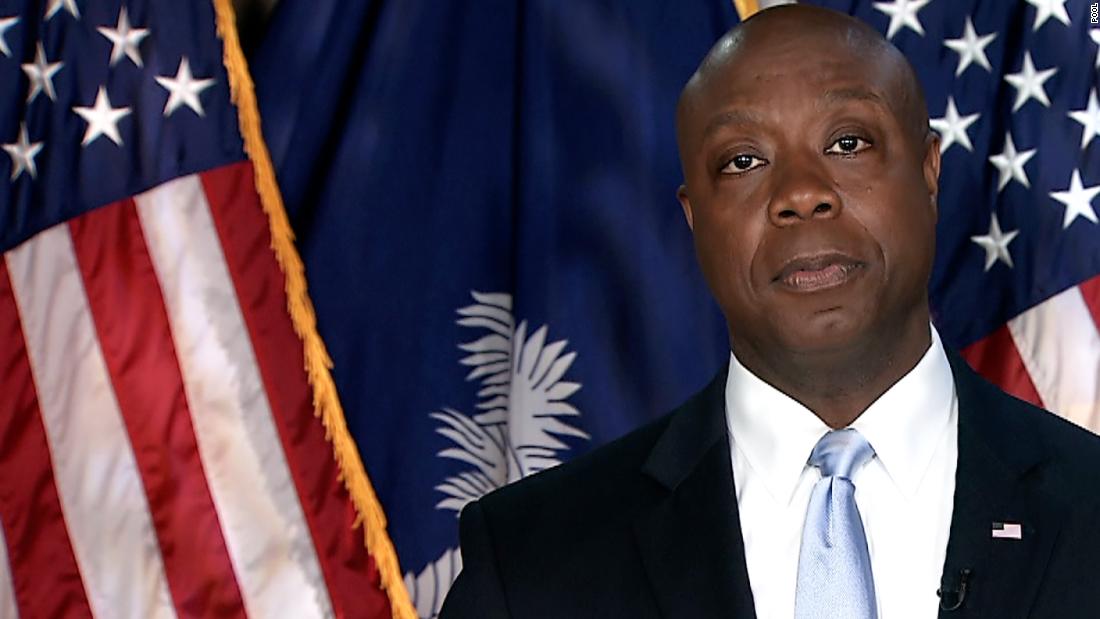Fact-checking GOP response to Biden’s joint address
Scott’s nearly 15-minute rebuttal to Biden’s hour-long speech was largely accurate, but some of his claims could have benefited from additional context.
Scott claimed, “Republicans support making it easier to vote and harder to cheat.”
Facts First: This needs context. We won’t weigh in on what Republicans around the country believe in their hearts, but it’s worth noting that Republican state legislators in numerous states are trying to pass measures that would reduce voter access in various ways.
Republican legislators in Texas, for example, have proposed this spring to prohibit 24-hour early voting sites and drive-through voting sites like those used in urban Harris County in 2020 and to forbid local officials from sending out absentee ballot applications to every registered voter, among other measures.
Republicans in various other states, including key swing states in presidential elections, have proposed multiple other measures that would reduce voter access. Some Republicans have also proposed expansions to early voting hours and other provisions to boost access, but the overall picture is certainly not even close to as solidly pro-access as Scott suggested.
-Daniel Dale
Infrastructure
Scott claimed Biden’s infrastructure plan is a “partisan wish list” with “less than 6%” going to roads and bridges.
Facts First: While around 6% of the roughly $2 trillion bill is dedicated to roads and bridges specifically, when accounting for other aspects of infrastructure as defined by Scott, the total percentage is more than double that.
The plan allocates $115 billion for modernizing highways, roads and main streets and $20 billion to improve road safety.
Biden’s plan also calls for $100 billion to build high-speed broadband infrastructure, $25 billion to airports and $17 billion for inland waterways, ports and ferries, the kinds of things Scott acknowledged should also be considered infrastructure.
Overall, Biden’s plan includes $621 billion for transportation, $400 billion for homecare service, $300 billion for manufacturing, $213 billion for housing, $180 billion for research and development, and $111 billion for water infrastructure.
-Tara Subramaniam
Schools reopening
During his rebuttal speech, Scott suggested that too many vulnerable kids’ schools were closed to in-person learning during the pandemic and that they should have reopened sooner.
“Locking vulnerable kids out of the classroom is locking adults out of their future. Our public schools should have reopened months ago,” he said.
Facts First: While it’s true that some public schools have yet to reopen for in-person learning, that number has fallen drastically since Biden took office. Yet critics maintain more could have been done to speed reopenings, and some point to Centers for Disease Control and Prevention guidance from February that slowed schools’ ability to reopen quicker.
As of April 20, K-12 schools in a little more than half of the 101 largest school districts in the country are offering full five-day-a-week in-person instruction for families that choose it, according to CNN’s tracking.
About 29% of K-12 students currently attend schools offering hybrid models that include both in-person and virtual instruction, and less than 6% have only virtual options, according to Burbio, which collects data from school calendars of thousands of schools across the country.
-Katie Lobosco
The economy under Trump
Scott said: “Just before COVID we had the most inclusive economy in my lifetime, the lowest unemployment rate ever recorded, African Americans, Hispanics and Asians, and a 70 year low nearly for women.
The unemployment rate for African Americans hit a new low, 5.2%, in August 2019. While the rate increased in the following months, its 6.0% level in February 2020 — before the Covid-related spike of March and April — was still lower than any recorded rate for African Americans prior to the Trump presidency, at least since the government began using its current methodology in the early 1970s.
It’s a similar story for Hispanics. Their unemployment rate hit a new low, 4.0%, in September 2019. It rose to 4.4% in February 2020, but that was still lower than any pre-Trump rate since the early 1970s.
The unemployment rate for women was 3.4% in February 2020. Aside from the 3.3% rate of September 2019, that was the lowest since 1953 — more than 66 years prior, close enough to justify Scott’s “nearly 70 years” claim.
For Asian Americans, the unemployment rate in two months in late 2019 was 2.4%, tied with the lowest pre-Trump rate on record, so there is a solid basis for Scott’s claim. However, the rates in other months during the late 2019-early 2020 period were slightly higher than that record; the January 2020 rate was 3.2% and the February 2020 rate was 2.5%. (Unlike the other data in this fact check, the data for Asian Americans is not seasonally adjusted, and it dates back only to 2000.)
-Daniel Dale
![]()


